When faced with an emergency situation where securing a door quickly is crucial, knowing how to barricade a door with a belt can be a valuable skill.

This technique can be particularly useful in scenarios such as active shooter situations or other immediate threats where traditional locking mechanisms are either not available or insufficient.
Using a belt to secure a door leverages common, accessible items and can buy precious time until help arrives.
This guide will walk you through the steps to effectively use a belt to barricade different types of doors, enhancing your safety and preparedness in critical moments.
Why Use a Belt?
Barricading a door with a belt has several advantages over other methods. First, belts are widely available and can be easily found on your person or nearby in most situations.
Additionally, they can provide more stability than makeshift barricades such as chairs or tables. Belts are also versatile and can be used to secure different types of doors, including those with lever handles, round knobs, or doorknobs.
It is important to note that while this technique can be effective, it is not a foolproof method and should not be relied on as the sole means of protection. It is always best to also have a plan in place for evacuation or seeking shelter in a secure location.
Things to Consider Before Attempting to Barricade a Door With a Belt
Before attempting to barricade a door with a belt, several critical factors should be taken into account to ensure the method’s effectiveness and safety. Firstly, assess the type of door and handle you are dealing with.
This technique is most effective on doors with lever handles, as the belt can be looped around the lever to prevent it from being pushed down. For round knobs or doorknobs, the belt can be used to create friction or tied to another stable object, but this may not be as reliable.
Secondly, consider the strength and condition of the belt itself. A sturdy, well-constructed belt with a robust buckle will offer more security than a thin or worn-out one. Leather belts or those made from durable synthetic materials generally provide better results.
Additionally, evaluate the immediate environment and available alternatives. If more robust means of barricading the door are available, such as furniture or specialized door security devices, these should be prioritized.
The surrounding environment can also impact the effectiveness of a belt barricade, such as the presence of external pressure or the specific nature of the threat.
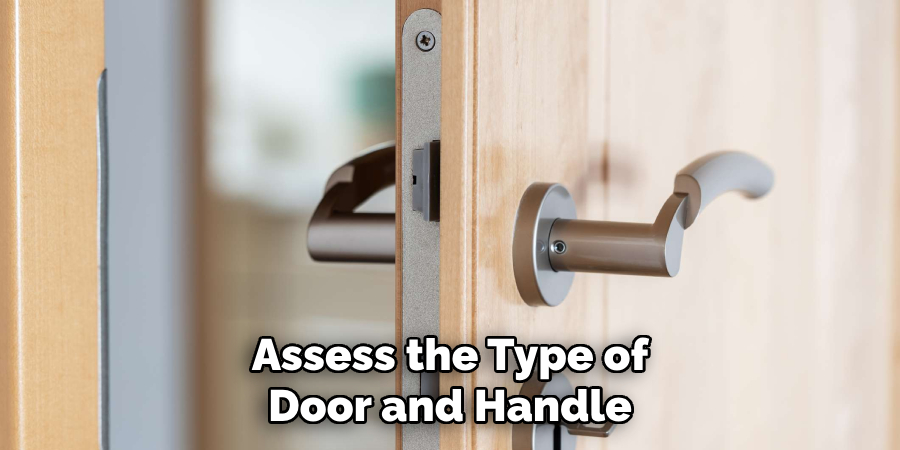
Lastly, always keep a clear path for evacuation if circumstances change. While barricading can buy time, it should not compromise your ability to escape to safety if the opportunity arises. Always be prepared to adapt your strategy based on the evolving situation.
Needed Materials
- A Belt (Preferably Sturdy and Wide)
- A Door With a Lever Handle, Round Knob, or Doorknob
7 Steps on How to Barricade a Door With a Belt
Step 1: Choose the Right Belt
Selecting the appropriate belt is crucial for effectively barricading a door. Opt for a belt that is sturdy and made of strong, durable materials such as leather or high-quality synthetic fibers.
The belt should be wide enough to provide sufficient friction and stability when looped around the door handle. Additionally, ensure that the belt has a robust buckle that can withstand pressure and tension without breaking.
Avoid thin or worn-out belts as they may not hold up under stress and could compromise your safety. A well-chosen belt will significantly enhance the effectiveness of this barricading method, buying you vital time in emergency situations.
Step 2: Assess the Door and Handle
Before proceeding, take a moment to thoroughly assess the door and its handle. Identify whether the door has a lever handle, round knob, or traditional doorknob, as the application of the belt will vary slightly depending on the type.
Lever handles are the most straightforward for this method, as the belt can be looped securely around the lever to prevent it from being pulled down. For round knobs or doorknobs, you’ll need to loop the belt tightly, creating friction to hinder the handle’s movement or tie it to a stable object to restrict rotation.
Additionally, evaluate the door’s material and durability. A heavy, solid-core door will offer more resistance to force compared to a lightweight, hollow-core door. Understanding these aspects will help you determine the best way to apply the belt and enhance the barricade’s effectiveness.
Ensure the handle mechanism itself is in good working condition, as a faulty handle could reduce the overall security of the barricade. Taking the time to make these observations can significantly improve the success of your barricading efforts.
Step 3: Prepare the Belt
Once you have assessed the door and handle, it is essential to prepare the belt to ensure it is ready for use in barricading the door. Begin by unfastening the belt and fully extending it to its maximum length.
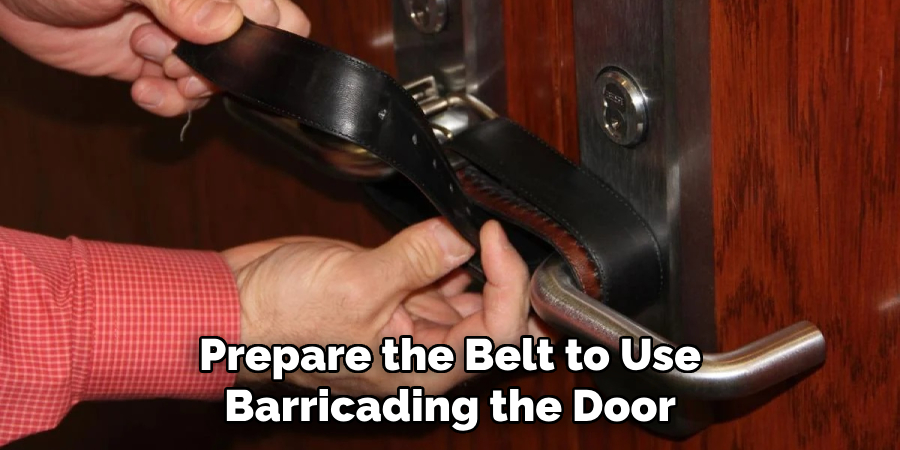
This will provide you with the greatest amount of material to work with, allowing for a secure and tight loop around the door handle. Inspect the belt for any defects or weak points that could compromise its integrity, such as frays or tears.
If any are found, consider using a different, more reliable belt if available. Next, decide on the best way to position the belt.
For lever handles, plan to loop the belt around the handle and then secure it to a fixed object or anchor point, such as a heavy piece of furniture, a door hinge, or a sturdy hook.
For round knobs or doorknobs, you might need to wrap the belt multiple times to ensure it stays tightly in place and creates enough friction to impede the handle’s movement. Preparing the belt in advance allows for a swift and efficient execution of the barricading process when time is of the essence.
Step 4: Loop the Belt Around the Handle
Place the belt around the handle and pull it taut, making a loop. The length of the loop will depend on your door’s dimensions and handle type, but aim to create a snug fit that does not leave any slack in the belt.
For lever handles, place the loop on one side of the handle, ensuring it doesn’t interfere with its movement or accidentally depress it. With round knobs or doorknobs, you have more flexibility in where you position the loop as long as it creates enough friction to prevent rotation.
Looping the belt around the handle is the most crucial step in this method as it forms the foundation of the barricade. Take your time to ensure the loop is secure and tight, using both hands if necessary.
A poorly executed loop will significantly weaken the barricade’s effectiveness and could render it useless in an emergency situation.
Step 5: Secure the Belt to a Fixed Object
If you have a lever handle, securing one end of the belt to a stable object or anchor point will significantly enhance its strength and stability. This can be done by tying it tightly around a heavy piece of furniture, such as a desk or dresser, or looping it around a door hinge and securing it in place.
For round knobs or doorknobs, you can also utilize this step by tying one end of the belt to a stable object or wrapping it around a hook or doorknob on the opposite side of the door. This will add an extra layer of reinforcement to the barricade and make it more challenging to break through.
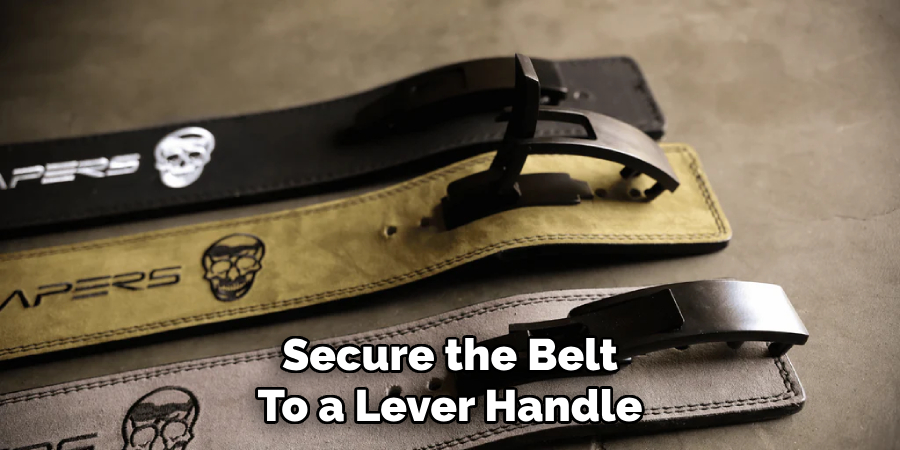
Step 6: Pull Tight and Check for Slack
Once the belt is secured, pull it as tight as possible while still maintaining a safe distance from the door’s edge. This will create more friction and tension against the handle, making it harder to move and breakthrough.
After pulling tight, check for any slack in the belt and adjust accordingly. Any loose areas could compromise the barricade’s integrity and should be addressed before moving on to the next step.
You may need to experiment with the placement and tightness of the belt to achieve the desired level of resistance. It is essential to take your time and make any necessary adjustments for maximum effectiveness.
Step 7: Test the Barricade
Before considering the door successfully barricaded, test it by trying to open it yourself or having someone else attempt to enter from outside.
This will give you an idea of how strong and secure the barricade is and allow for any necessary adjustments to be made. If there are still weak spots or areas where the belt has come loose, address them immediately before the situation escalates.
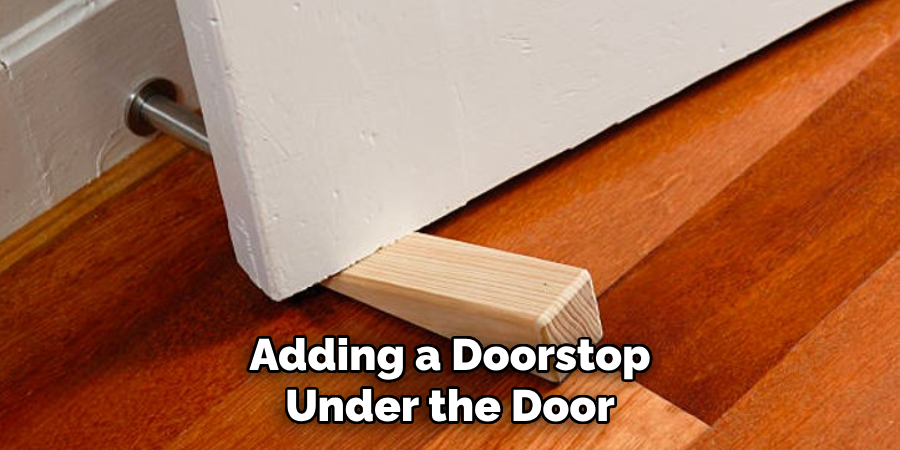
Following these steps on how to barricade a door with a belt will help you create a strong and effective barricade using a simple belt. Remember to regularly assess and maintain the barricade to ensure its reliability in emergency situations. Stay safe, and stay prepared!
Additional Tips for Enhancing Barricade Effectiveness
- Use multiple belts or straps to reinforce the barricade further.
- Consider adding a doorstop or wedge under the door for added support.
- Utilize heavy objects, such as furniture or appliances, to create a physical barrier in front of the door.
- Have a plan for quickly and efficiently barricading multiple doors in your home or office.
- Practice and familiarize yourself with how to execute these steps in case of an emergency.
- Keep spare belts or straps easily accessible in case one becomes damaged or unavailable.
- Regularly evaluate the condition and functionality of door handles, locks, and other components involved in securing the door. Replace any faulty parts promptly.
By following these additional tips, you can further enhance the effectiveness of your barricade and increase your safety during emergency situations. Stay vigilant, and stay prepared!
Frequently Asked Questions
Q: Can I Use Any Type of Belt to Barricade a Door?
A: It is recommended to use a sturdy, heavy-duty belt for maximum effectiveness. Thin or flimsy belts may not provide enough support and could break under pressure.
Q: Is This Method Suitable for All Types of Doors?
A: This method is most effective on doors with lever handles or round knobs/doorknobs. For sliding doors or other types, consider using alternative barricading methods such as placing a heavy object in front of the door.
Q: Can I Barricade a Door Without a Fixed Object to Secure the Belt To?
A: While it is recommended to use a fixed object for added reinforcement, you can still create a barricade by tightly tying both ends of the belt around the door handle and pulling it taut. However, this may not be as strong as using a fixed object.
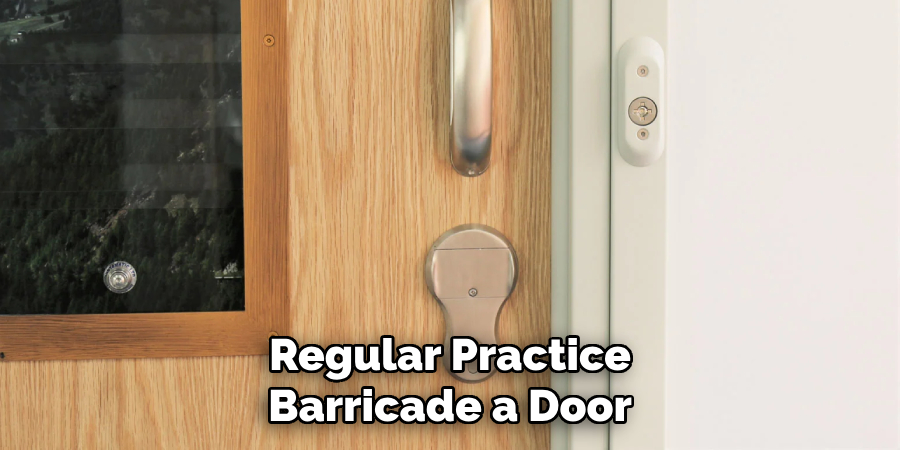
Conclusion
In emergency situations, knowing how to efficiently barricade a door using a simple tool like a belt can be a crucial skill.
By following the outlined steps on how to barricade a door with a belt and employing additional tips for reinforcing barricades, you can significantly improve your safety and security.
Regular practice and preparation will ensure that you can swiftly and effectively implement these techniques when necessary. Stay vigilant, stay prepared, and prioritize your safety at all times.
About
Safety Fic is a distinguished figure in the world of Diy design, with a decade of expertise creating innovative and sustainable Diy solutions. His professional focus lies in merging traditional craftsmanship with modern manufacturing techniques, fostering designs that are both practical and environmentally conscious. As the author of diy, Safety Fic delves into the art and science of Safety Fic-making, inspiring artisans and industry professionals alike.
Education RMIT University
(Melbourne, Australia) Associate Degree in Design (Safety Fic) Focus on sustainable design, industry-driven projects, and practical craftsmanship. Gained hands-on experience with traditional and digital manufacturing tools, such as CAD and CNC software.
Nottingham Trent University
(United Kingdom) Bachelor’s in diyfastly.com and Product Design (Honors) Specialized in product design with a focus on blending creativity with production techniques. Participated in industry projects, working with companies like John Lewis and Vitsoe to gain real-world insights.
Publications and Impact
In diy, Safety Fic his insights on indoor design processes, materials, and strategies for efficient production. His writing bridges the gap between artisan knowledge and modern industry needs, making it a must-read for both budding designers and seasoned professionals.
